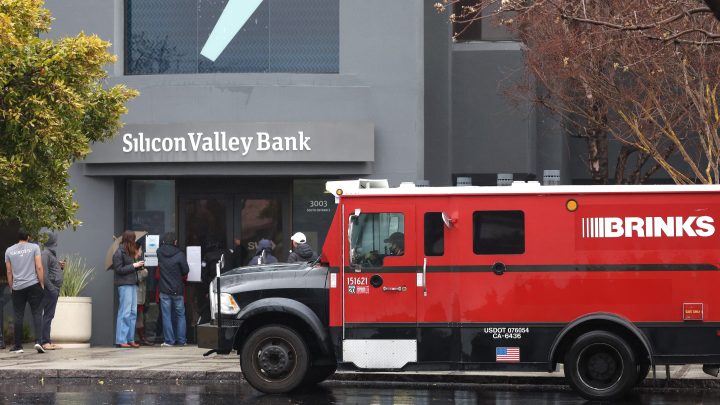
A year after Silicon Valley Bank failed, lenders are still feeling pressure on all sides
A year after Silicon Valley Bank failed, lenders are still feeling pressure on all sides

It’s been almost a year since the banking crisis kicked off last March. Signature Bank and Silicon Valley Bank failed. Eventually, First Republic Bank did too.
A year later, many businesses have said that they’re less concerned about their deposits than they were a year ago. But banks tell a different story: A lot of the problems that last year’s bank failures revealed are still troubling small and mid-sized banks today.
After Silicon Valley Bank’s initial failure, Chris Duncan, chief lending officer at La Salle State Bank in Illinois, said he and his staff were making a lot of calls to the bank’s depositors.
“Just to make sure they understood that the bank was safe, sound, that their deposits were secure,” Duncan said.
Duncan said people’s concerns died down after a few weeks, once they realized the banking crisis was contained. But then, around late March and early April, Duncan said depositors started calling with a different concern: whether their money was earning enough interest. Those calls are still coming in.
“They’ve done a nice job of educating themselves on what the local competition is offering, and calling the bank and requesting a match, or to beat, a competitor bank,” Duncan said.
The bank has been cranking up deposit rates ever since, he said. But there’s a problem on the other side of the bank’s balance sheet, he noted — with the interest rates on its loans.
“Because of the speed with which rates have increased on the Fed side, the loan rates really have not come close to catching up with the increases on the deposit side,” Duncan said.
Duncan said the bank also has a lot of money tied up in government bonds that it bought early in the pandemic, when many banks had lots of extra cash on hand. Unfortunately, those government bonds pay next to nothing in interest.
“We probably did that at the perfectly wrong time, with interest rates where they were just on the cusp on the Fed starting to raise the Fed rate,” Duncan said.
A bank can always sell off its government bonds, low-interest rate loans and other assets to raise cash.
But there’s a problem with that, cautioned Julie Hill, vice dean at the University of Alabama School of Law: “You could take that mortgage that’s at 3% and sell it, but no one wants to buy a 3% mortgage at face value,” Hill said. “Because if you make a new mortgage, you can charge more.”
If word gets around that a bank is selling assets at a loss, that can scare off depositors and cause them to pull out their money. That’s pretty much what happened to Silicon Valley Bank last year.
“All you need is concern about your earnings, or investments, or your commercial real estate, and suddenly, your deposits might turn from stable to less stable,” Hill said.
That said, some banks are trying to sell some of their assets anyway. A few weeks ago, New York Community Bank, which took over a lot of assets from the failed Signature Bank, said it’s considering selling off some commercial real estate debt to raise capital.
Earlier this month, the bank said its deposits are stable. But Hill said its willingness to sell is another sign that regional banks are still under a lot of pressure.
“I think we had sort of hoped that the banking woes were over,” she said. “But it’s not that bank balance sheets correct themselves overnight, even with good bank management.”
Getting rid of low-interest-rate loans isn’t the only way for a bank to stay afloat. Another is to make new loans at higher interest rates, said David Reiling, CEO of Sunrise Banks in Minnesota.
“If you’re able to raise more deposits, and then put that into current rate loans, you can grow your way out of the problem to a certain extent, or at least reduce the problem,” Reiling said.
That’s easier said than done, he said. A lot of banks just don’t have enough deposits on hand to lend out more money. But Reiling said his bank does. That’s giving it a chance to find new customers who can’t get loans at their existing banks.
“There are opportunities out there, and if that business keeps growing, and they need more credit, and the current bank can’t handle that, then we’re kind of ready, able and willing to assist and take on that good customer,” he said.
Plus, those businesses also have deposits. Over the last year, Reiling said his bank has been eyeing those too.
“They may come to us and we’ll say, ‘Great! We’ll do the loan for you, but you need to bring your depository relationship with it,’” he said. “’We also want your business checking account as well.’”
And that, Reiling added, is helping the bank lend even more.
There’s a lot happening in the world. Through it all, Marketplace is here for you.
You rely on Marketplace to break down the world’s events and tell you how it affects you in a fact-based, approachable way. We rely on your financial support to keep making that possible.
Your donation today powers the independent journalism that you rely on. For just $5/month, you can help sustain Marketplace so we can keep reporting on the things that matter to you.












